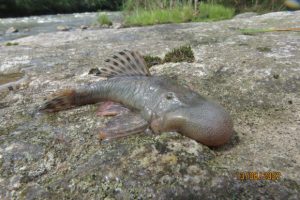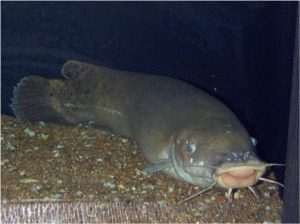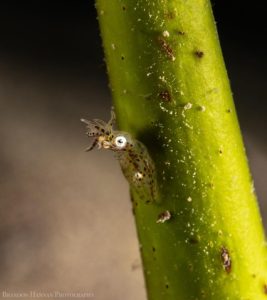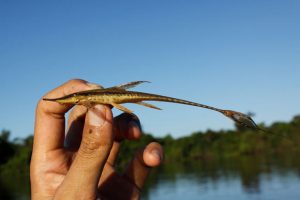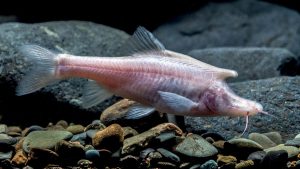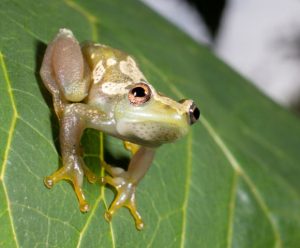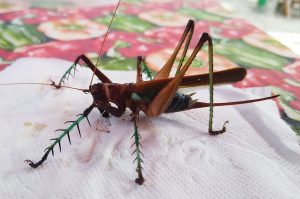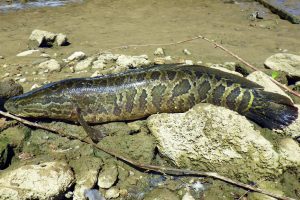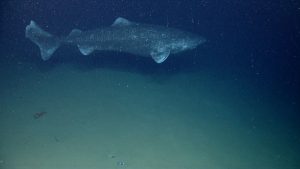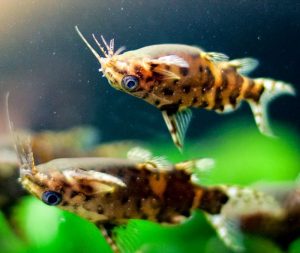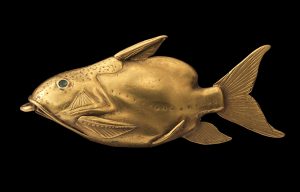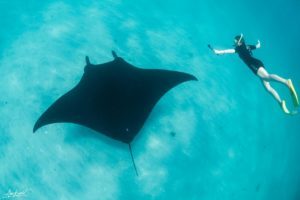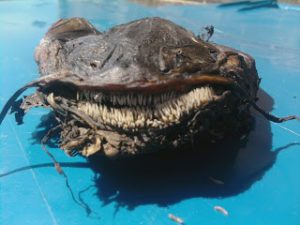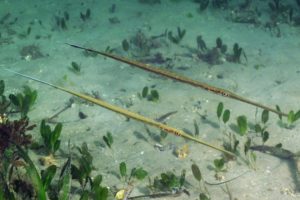Podcast: Play in new window | Download (Duration: 19:16 — 19.6MB)
While I’m at Dragon Con, here’s an old Patreon episode about Tennessee water mysteries, including some spooky sightings of what were probably bears, and some mystery fish!
Show transcript:
Welcome to Strange Animals Podcast. I’m your host, Kate Shaw.
As this episode goes live, I should be at Dragon Con, so I decided to go ahead and schedule an old Patreon episode to run instead of trying to get a new episode ready in time. It’s about some water mysteries in my home state of Tennessee, although I actually just moved away from Tennessee to Georgia.
Tennessee is in the southeastern United States, a long thin state divided into three geographical sections. East Tennessee borders the southern Appalachian Mountains, Middle Tennessee is on the Cumberland Plateau, and West Tennessee borders the Mississippi River. The only natural lake in the state is Reelfoot in northwestern Tennessee, a shallow, swampy body of water formed in the early 19th century.
Before 1811, instead of a lake a small river flowed through the area, a tributary of the Mississippi. In earlier accounts, Reelfoot River is called Red Foot River. Most of the residents of the area at the time were Choctaw, although white settlers lived in the small town of New Madrid near the bank of the Mississippi.
From December 1811 through February 1812, a series of earthquakes in the New Madrid Seismic Zone changed the land radically. There were three main quakes and innumerable smaller ones, ranging from an estimated 6.7 for the smallest quake to a possible 8.8 for the largest.
In the initial quake and aftershocks on 16 December 1811, chimneys collapsed, trees fell, and fissures opened and closed, projecting water or sand high in the air. Boats on the Mississippi capsized as huge waves crashed from bank to bank.
A woman named Eliza Bryan, who lived in New Madrid, wrote an account of the quakes:
On the 16th of December, 1811, about 2 o’clock a.m., a violent shock of earthquake, accompanied by a very awful noise, resembling loud but distant thunder, but hoarse and vibrating, followed by complete saturation of the atmosphere with sulphurous vapor, causing total darkness. The screams of the inhabitants, the cries of the fowls and beasts of every species, the falling trees, and the roaring of the Mississippi, the current of which was retrograde for a few minutes, owing, as it is supposed, to an eruption in its bed, formed a scene truly horrible.
From this time on until the 4th of February the earth was in continual agitation, visibly waving as a gentle sea. On that day there was another shock…and on the 7th, at about 4 o’clock a.m., a concussion took place so much more violent than those preceding it that it is denominated the ‘hard shock.’
The Mississippi first seemed to recede from its banks, and its waters gathered up like a mountain… Then, rising 15 or 20 feet perpendicularly and expanding, as it were, at the same time, the banks overflowed with a retrograde current rapid as a torrent.
A riverboat captain reported in another account that his boat was caught in a ferocious current on the Mississippi, crashing across waves he estimated as six feet high, or 1.8 m. He also reported whirlpools that he estimated were 30 feet deep, or 9 m. He saw all the trees on either bank fall at once.
The December quake was so large it was felt across North America, from Canada to the Gulf Coast. Then, only five weeks later, it happened again, followed by the third major earthquake on 7 February. Only 15 miles, or 24 km, from the epicenter, the land dropped 20 feet, or 6 m, and created a basin that immediately filled with water. Reelfoot Lake was formed, Tennessee’s only natural lake.
Reelfoot is a state park these days, popular with boaters, fishers, hunters, and birdwatchers. The only cryptid sighting I could find took place in the Glass community near Obion, within ten miles, or 16 km, of the lake. A man who grew up in Glass reported in 2009 that a bipedal creature 8 or 9 feet tall, or 2.5-2.7 m, and covered in off-white hair was well-known to the residents of the community. They referred to it as “the white thing.” The man had seen it several times as a child and his father, who was initially a skeptic, changed his mind when he found huge tracks in the woods.
Technically, Tennessee has two natural lakes, but the “Lost Sea” is underground. It’s located in a large cave system called Craighead Caverns in the foothills of the Great Smoky Mountains. It’s one of the largest underground lakes ever found, although it hasn’t been fully explored so its actual size isn’t known. The lake doesn’t support any known animals, although scientific explorations haven’t been conducted as far as I could find. In the 1960s the cave owners stocked the lake with rainbow trout in hopes that they would discover an exit to the surface. They didn’t, and the fish have to be fed and restocked since they have no natural food sources and won’t spawn in the lake. The cave, and the lake, are a local tourist attraction.
Besides Reelfoot Lake, Tennessee is home to many man-made lakes. Most are in East Tennessee. During the Great Depression, President Roosevelt set up the New Deal plan, creating government-funded projects to employ out-of-work Americans. The Tennessee Valley Authority was founded in 1933 to improve the lives of people who lived along the Tennessee River and its tributaries. To curb seasonal flooding and stop the spread of malaria, and to bring electricity to residents, TVA built numerous hydroelectric dams.
I grew up in a town built in the 1930s to house workers on Norris Dam, which formed Norris Lake from the Clinch River. Norris Dam was TVA’s first large project, completed in 1936. This makes the lake only 85 years old, but that’s certainly long enough for local lore to grow up around it. As a kid I heard about monster catfish—as big as a VW Beetle—living at the bottom of the spillway. The largest fish ever caught in the lake, however, was a 49.5 pound, or 22.45 kg, striped bass in 1978. The largest catfish ever caught in Tennessee was a blue catfish that weighed 112 pounds, or 50.8 kg. That’s huge, but not the size of a car.
There are other strange reports from around Norris Lake. On the night of 3 March 2012, two men went to a clearing near the first man’s house, in a swampy area near the lake’s edge, to build a bonfire and talk. They noticed footsteps and the sound of a large animal moving around in the trees nearby but assumed it was a white-tailed deer, although both men did have the sensation of being watched throughout the evening. Around midnight, when the men decided to leave, they heard sticks breaking in the trees as though being stepped on. One of the men knocked on a tree with a piece of wood and heard knocking in response, and then both were frightened by a loud, deep, long growl.
Black bears do occasionally stray into the Norris area from the nearby Smoky Mountains, but black bears don’t growl—they make distinctive moaning or chuffing noises instead. They also usually stay away from humans and fire.
In the late 1980s, possibly September of 1988, a woman returning to her car after a day of fishing with her family saw a huge hairy Bigfoot-type figure cross the trail ahead of her at speed. She only caught a quick glimpse of it at dusk but estimated it was 8 or 9 feet tall, or 2.5-2.7 m, with long arms that swung oddly as it took huge strides.
Other Tennessee lakes have their share of mysteries too. The “catzilla” legend is repeated in just about every waterway, with the catfish’s size usually compared to that of a small car. There really are some enormous fish in Tennessee’s lakes, though. In January of 2021 a man caught and released an American paddlefish in Cherokee Lake that might have approached the world record weight of 151 pounds, or 68.5 kg. It was six feet long, or 1.8 m.
There’s also a 19th century mystery associated with the Tennessee River. The earliest report of it I could find is from April 1878 in the Chattanooga Daily Times, an account from an old resident about river monster sightings from earlier that century. The first sighting by a white settler is from 1822, when a man named Buck Sutton was fishing and sighted the monster. The next reported sighting was near the same area five years later, when a man named Billy Burns saw the monster while crossing the ferry. Jim Windom was fishing in 1829 when he saw it. All three men died the summer after their encounters, although subsequent sightings (including 1836 and 1839) didn’t lead to anyone’s death.
The sightings all apparently took place in a part of the Tennessee River near Chattanooga, now dammed to form Chickamauga Lake. At the time the river there was relatively sluggish and shallow, with many shoals.
The monster was described as serpent-like and about the length of a canoe, or around 20 to 25 feet long, or 6 to 7.6 m. At least one report says it had a doglike head. Billy Burns reported that its belly was yellow and its back was blue. The most interesting detail comes from at least two reports, that of a tall black fin on its back that stood at least 18 inches high, or 45 cm, or possibly two feet high, or 61 cm.
The Tennessee River has its share of unusual animals, from tiny freshwater jellyfish to the paddlefish, a filter feeder with an elongated rostrum, but nothing with such a large and prominent dorsal fin. The lake sturgeon, which can grow well over seven feet long, or 2.2 m, has bony plates on its back and an elongated snout, which doesn’t fit the description given by witnesses. The alligator gar can grow 10 feet long, or 3 m, but like the lake sturgeon, its dorsal fin is small and set far back on the body. The longnose gar can grow six feet long, or 1.8 m, but again, its dorsal fin is small and set far back on its body, and as its name implies, its jaws are elongated.
In shallow water the tail fins of any of these fish or others can show above the surface higher than the dorsal fin, but not two feet out of the water. Moreover, all these fish were much more common in the early 19th century than they are now, and locals would likely recognize all of them.
Alligators do occasionally show up in Tennessee, although not historically. Most alligator sightings are quite recent. The American alligator can grow up to 15 feet long, or 4.5 m, but even if one occasionally strayed into the Tennessee River in the 19th century, it has no structure on its back that could be mistaken for a tall fin.
On rare occasions, a bull shark could find its way into the Tennessee River. The Tennessee is a tributary of the Ohio River, which in turns flows into the Mississippi, which then empties into the Gulf of Mexico. While bull sharks do occasionally swim up the Mississippi, no genuine sighting of one in the Ohio or Tennessee rivers has ever been documented. It’s not impossible, though. An exceptionally large bull shark can grow up to 13 feet long, or 4 m, and it prefers shallow water. Tennesseans in the early 19th century would have no knowledge of sharks and might consider it a monster, not an ordinary fish.
It’s possible that the Tennessee River was once home to a large fish with a tall dorsal fin, one that was already rare in the early 19th century and which went extinct soon after. It’s also possible that the story was just a newspaper hoax, written to fill space on a slow news day. The article from 1878 was a “contribution…from an old citizen of Chattanooga” who was not named, talking about events that took place more than fifty years before. In 1885 another newspaper, the Chattanooga Daily Commercial, ran a nearly identical article—obviously taken from the 1878 one, often word-for-word—that claims the reporter heard the story “yesterday while listening attentively to the conversation of one of Chattanooga’s oldest citizens.”
We may never know what the strange Tennessee River animal was, just as we may not know whether bigfoot-type creatures live near Tennessee’s lakes. I have my doubts that there are catfish in Tennessee bigger than cars, though—but just to be on the safe side, I’m staying in the boat.
Thanks for your support, and thanks for listening!
